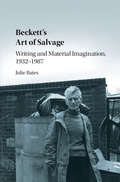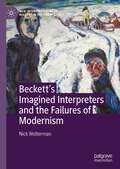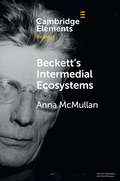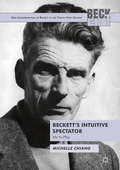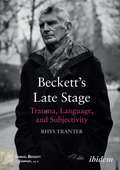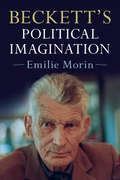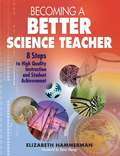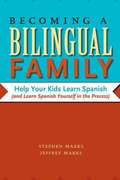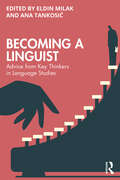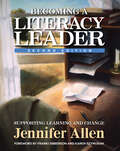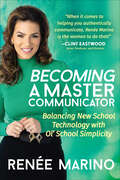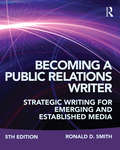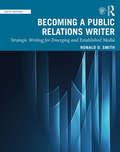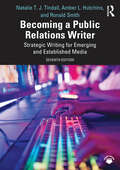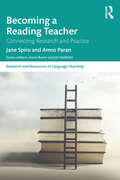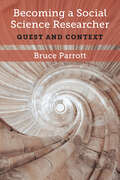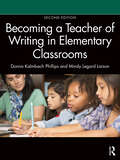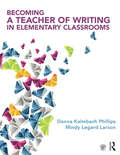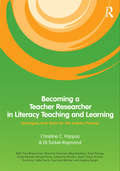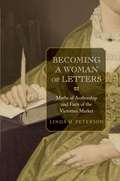- Table View
- List View
Beckett's Art of Mismaking
by Leland de la DurantayeLeland de la Durantaye helps us understand Beckett's strangeness and notorious difficulty by arguing that Beckett's lifelong campaign was to mismake on purpose--not to denigrate himself, or his audience, or reconnect with the child or savage within, but because he believed that such mismaking is in the interest of art and will shape its future.
Beckett’s Art of Salvage
by Julie BatesThis innovative exploration of the recurring use of particular objects in Samuel Beckett's work is the first study of the material imagination of any single modern author. Across five decades of aesthetic and formal experimentation in fiction, drama, poetry and film, Beckett made substantial use of only fourteen objects - well-worn not only where they appear within his works but also in terms of their recurrence throughout his creative corpus. In this volume, Bates offers a striking reappraisal of Beckett's writing, with a focus on the changing functions and impact of this set of objects, and charts, chronologically and across media, the pattern of Beckett's distinctive authorial procedure. The volume's identification of the creative praxis that emerges as an 'art of salvage' offers an integrated way of understanding Beckett's writing, opens up new approaches to his work, and offers a fresh assessment of his importance and relevance today.
Beckett's Dedalus
by Peter J. MurphyGiven that the Nobel Prize-winning author Samuel Beckett (1906-1989) was personally acquainted with the modernist master James Joyce, and even helped research and promote Finnegans Wake, it should come as no surprise that Beckett was greatly influenced by Joyce's own work. However, much analysis of Beckett's work tends to argue that he forged his own artistic identity in opposition to Joyce, seeking and eventually finding styles and methods unoccupied by his "mentor." Beckett's Dedalus is a comprehensive reassessment of this line of criticism and traces the nature and extent of Joyce's influence in more complex, contestatory, and complementary ways throughout all of Beckett's major fiction. Paying close attention to the extensive network of allusions Beckett derived from Joyce's writing, P.J. Murphy reveals how Beckett consistently echoed and engaged in dialogue with Joyce's works, especially A Portrait of the Artist as a Young Man and, in particular, its protagonist Stephen Dedalus. This study proposes that the relationship between the two writers was a complex life-giving and art-building dialogue concerned with aesthetic theories, depictions of reality, and the artistic integrity needed to carry out these critical investigations. Beckett's Dedalus is a fascinating study of the literary influence one generation has on the next. It will change the way we consider the relationship between two of the greatest writers of the twentieth century.
Beckett’s Imagined Interpreters and the Failures of Modernism (New Interpretations of Beckett in the Twenty-First Century)
by Nick WoltermanSamuel Beckett’s work is littered with ironic self-reflexive comments on presumed audience expectations that it should ultimately make explicable sense. An ample store of letters and anecdotes suggests Beckett’s own preoccupation with and resistance to similar interpretive mindsets. Yet until now such concerns have remained the stuff of scholarly footnotes and asides. Beckett’s Imagined Interpreters and the Failures of Modernism addresses these issues head-on and investigates how Beckett’s ideas about who he writes for affect what he writes. What it finds speaks to current understandings not only of Beckett’s techniques and ambitions, but also of modernism’s experiments as fundamentally compromised challenges to enshrined ways of understanding and organizing the social world. Beckett’s uniquely anxious audience-targeting brings out similarly self-doubting strategies in the work of other experimental twentieth-century writers and artists in whom he is interested: his corpus proves emblematic of a modernism that understands its inability to achieve transformative social effects all at once, but that nevertheless judiciously complicates too-neat distinctions drawn within ongoing culture wars. For its re-evaluations of four key points of orientation for understanding Beckett’s artistic ambitions—his arch critical pronouncements, his postwar conflations of value and valuelessness, his often-ambiguous self-commentary, and his sardonic metatheatrical play—as well as for its running dialogue with wider debates around modernism as a social phenomenon, this book is of interest to students and researchers interested in Beckett, modernism, and the relations between modern and contemporary artistic and social developments.
Beckett's Intermedial Ecosystems: Closed Space Environments across the Stage, Prose and Media Works (Elements in Beckett Studies)
by Anna McMullanThis Element draws on the concept of ecosystems to investigate selected Beckett works across different media which present worlds where the human does not occupy a privileged place in the order of creation: rather Beckett's human figures are trapped in a regulated system in which they have little agency. Readers, listeners or viewers are complicit in the operation of techniques of observation inherent to the system, but also reminded of the vulnerability of those subjected to it. Beckett's work offers new paradigms and practices which reposition the human in relation to space, time and species.
Beckett's Intuitive Spectator: Me to Play (New Interpretations of Beckett in the Twenty-First Century)
by Michelle ChiangBeckett’s Intuitive Spectator: Me to Play investigates how audience discomfort, instead of a side effect of a Beckett pedagogy, is a key spectatorial experience which arises from an everyman intuition of loss. With reference to selected works by Henri Bergson, Immanuel Kant and Gilles Deleuze, this book charts the processes of how an audience member’s habitual way of understanding could be frustrated by Beckett’s film, radio, stage and television plays. Michelle Chiang explores the ways in which Beckett exploited these mediums to reconstitute an audience response derived from intuition.
Beckett's Late Stage: Trauma, Language, and Subjectivity (Samuel Beckett in Company #4)
by Rhys TranterBeckett's Late Stage reexamines the Nobel laureate's postwar prose and drama in the light of contemporary trauma theory. Through a series of sustained close readings, the study demonstrates how the comings and goings of Beckett's prose unsettles the Western philosophical tradition; it reveals how Beckett's live theatrical productions are haunted by the rehearsal of traumatic repetition, and asks what his ghostly radio recordings might signal for twentieth-century modernity. Drawing from psychoanalytic and poststructuralist traditions, Beckett's Late Stage explores how the traumatic symptom allows us to rethink the relationship between language, meaning, and identity after 1945.
Beckett's Political Imagination
by Emilie MorinBeckett's Political Imagination charts unexplored territory: it investigates how Beckett's bilingual texts re-imagine political history, and documents the conflicts and controversies through which Beckett's political consciousness and affirmations were mediated. The book offers a startling account of Beckett's work, tracing the many political causes that framed his writing, commitments, collaborations and friendships, from the Scottsboro Boys to the Black Panthers, from Irish communism to Spanish republicanism to Algerian nationalism, and from campaigns against Irish and British censorship to anti-Apartheid and international human rights movements. Emilie Morin reveals a very different writer, whose career and work were shaped by a unique exposure to international politics, an unconventional perspective on political action and secretive political engagements. The book will benefit students, researchers and readers who want to think about literary history in different ways and are interested in Beckett's enduring appeal and influence.
Becoming a Better Science Teacher: 8 Steps to High Quality Instruction and Student Achievement
by Elizabeth Hammerman Dave YoungsIn today’s standards-based educational climate, teachers are challenged to create meaningful learning experiences while meeting specific goals and accountability targets. In her essential new book, Elizabeth Hammerman brings more than 20 years as a science educator and consultant to help teachers connect all of the critical elements of first-rate curriculum and instruction.With this simple, straight-on guide, teachers can analyze their existing curriculum and instruction against a rubric of indicators of critical characteristics, related standards, concept development, and teaching strategies to develop students’ scientific literacy at the highest levels. Every chapter is packed with charts, sample lesson ideas, reflection and discussion prompts, and more, to help teachers expand their capacity for success.Hammerman describes what exceptional teaching looks like in the classroom and provides practical, teacher-friendly strategies to make it happen. This research-based resource will help teachers: Reinforce understanding of standards-based concepts and inquiry Add new content, methods, and strategies for instruction and assessment Create rich learning environments Maximize instructional time Ask probing questions and sharpen discussion Include technology Gather classroom evidence of student achievement to inform instructionThrough a new, clear vision for high quality science teaching, this book gives teachers everything they need to deliver meaningful science instruction and ensure student success and achievement.
Becoming a Bilingual Family: Help Your Kids Learn Spanish (and Learn Spanish Yourself in the Process)
by Stephen Marks Jeffrey MarksWould you like your children to grow up bilingual, even if you aren't yet? Then speak to your kids in Spanish as you learn the language along with them. Becoming a Bilingual Family gives English-speaking parents the tools to start speaking Spanish with their kids in their earliest years, when children are most receptive to learning languages. It teaches the vocabulary and idioms for speaking to children in Spanish and offers practical, proven ways to create a language-learning environment at home. The first part of the book introduces parents to many resources--books, audio books, music, television, computer programs, childcare workers, school, and friends--that can help you establish a home environment conducive to the acquisition of Spanish. The second part is a Spanish phrasebook that takes you through all the typical activities that parents and children share, from getting up in the morning to going to bed at night. Few, if any, other Spanish study aids provide this much vocabulary and guidance for talking to small children about common daily activities. The authors also include a quick course in Spanish pronunciation and enough grammar to get a parent started. Spanish-language resources, kids' names in Spanish, and an easy-to-use index and glossary complete the book. Take the Markses' advice and start talking to your kids in Spanish, even if it's not perfect. You'll learn the language together and share the excitement of discovering the peoples and cultures that make up the Spanish-speaking world.
Becoming a Linguist: Advice from Key Thinkers in Language Studies
by Milak, Edited by EldinThis unique collection of essays, edited by and for students of linguistics, offers insights into the personal and professional journeys of some of the key thinkers in language studies.With contributions by fifteen established scholars, the volume provides first-hand insights into the ‘becoming’ of a linguist, and the many joys and challenges which come with it. The contributors pair honest and practical academic advice with personal experiences to assist novice and aspiring linguists to find their footing in the rapidly changing landscape of language studies, and guide them through linguistics past, present, and future. Autobiographical and reflexive, each chapter also includes recommendations for key readings and resources used or produced by the contributors.As a volume focused on the people behind the ideas, Becoming a Linguist will be of interest to students and scholars of language and linguistics, the history of linguistic thought, as well as the interested general reader.
Becoming a Literacy Leader: Supporting Learning and Change
by Jennifer AllenIn this second edition of Becoming a Literacy Leader: Supporting Learning and Change, author Jennifer Allen reflects on her work as a literacy specialist and how the role has evolved in the decade since she wrote the first edition. Her experiences can apply to all school leaders including principals, coaches, teachers, support staff, and office administrators. Allen focuses on three ideas to describe her work: Layered Leadership, the multitude of supports in place for teachers to encourage learning and change within schools; Shared experiences that develop community and develop common understanding of practices, curriculum, and assessment; Importance of 'rowing in the same direction' in that literacy coaches and leaders stay interconnected and aligned to the goals of the school. Allen knows the challenges of teachers face and advocates literacy coaches implement these layers of support within a school, including in-class support, curriculum support and assessment, study group facilitation, and the cultivation of teacher leadership. In Becoming a Literacy Leader, she provides an explicit framework for implementing these layers of coaching and explains how administrators can use the literacy leader position to build and sustain change within their schools. This book will be the road map for how literacy leaders and coaches approach their work with purpose and intention. Online videos that accompany the book bring the text alive by showing readers what coaching looks and sounds like.
Becoming a Master Communicator: Balancing New School Technology with Ol' School Simplicity
by Renée MarinoBecoming a Master Communicator is a practical and exciting guidebook from communication coach and Broadway actress Renée Marino. &“Renée has made it her obsession to help everyday people master communication with simple processes and tools. If you strive for higher purpose or success, then learning these principles is a must.&” —New York Times–bestselling author Dean Graziosi Renée Marino offers an essential guide for those looking to have clear and authentic communication with others by using digital technology as a tool—but not the only tool. Smartphones and computers make everyday communication incredibly convenient. However, when used as an individual&’s sole source of connection, it can make one forget real human contact and interaction are incredibly vital, thus causing unnecessary misunderstandings. Through personal stories and easily applicable practices, Renée explains how to become a master communicator in personal and professional settings by knowing when to use digital technology and when to put the devices down to have a direct conversation. Discover how to: Establish true self-confidence, fulfilling relationships, and an extraordinary career. Use simple and practical tools to strengthen your communication muscles every day. Save time, energy, and stress by getting right to the heart of a communication matter. Become a powerful leader in your professional life. Take hold of every opportunity that comes across your path. Experience more joy, gratitude, and presence each day. Claim who you want to be and the life you want to lead. Everything starts with communication, and when you can communicate confidently and honestly, you become unstoppable. That journey begins here.
Becoming a Poet in Anglo-Saxon England
by Emily V. ThornburyCombining historical, literary and linguistic evidence from Old English and Latin, Becoming a Poet in Anglo-Saxon England creates a new, more complete picture of who and what pre-Conquest English poets really were. It includes a study of Anglo-Saxon words for 'poet' and the first list of named poets in Anglo-Saxon England. Its survey of known poets identifies four social roles that poets often held - teachers, scribes, musicians and courtiers - and explores the kinds of poetry created by these individuals. The book also offers a new model for understanding the role of social groups in poets' experience: it argues that the presence or absence of a poetic community affected the work of Anglo-Saxon poets at all levels, from minute technical detail to the portrayal of character. This focus on poetic communities provides a new way to understand the intersection of history and literature in the Middle Ages.
Becoming a Public Relations Writer: Strategic Writing for Emerging and Established Media
by Ronald D. SmithBecoming a Public Relations Writer is a comprehensive guide to the writing process for public relations practice. Using straightforward, no-nonsense language, realistic examples, easy-to-follow steps, and practical exercises, this text introduces the various formats and styles of writing you will encounter as a public relations practitioner. A focus on ethical and legal issues is woven throughout, with examples and exercises addressing public relations as practiced by corporations, non-profit agencies, and other types of organizations both large and small. In addition, the book offers the most comprehensive list of public relations writing formats to be found anywhere--from the standard news release to electronic mail and other opportunities using a variety of technologies and media. The fifth edition has been updated to reflect significant developments in the public relations field, including: New and updated information on research into persuasion and social psychology aimed at helping readers be more influential in their writing. Significant updating on a new chapter on multimedia, introducing a new transmedia format for a comprehensive news package for print, broadcast, online and social media. Expansion of a chapter on websites, blogs and wikis. Expansion of the chapter on direct mail and online appeals. Updated examples of actual pieces of public relations writing. A companion website with resources for instructors and students, including a glossary, flashcards, exercises, and appendices on ethical standards, careers in public relations, and professional organizations. Through its comprehensive and accessible approach, Becoming a Public Relations Writer is an invaluable resource for future and current public relations practitioners.
Becoming a Public Relations Writer: Strategic Writing for Emerging and Established Media
by Ronald D. SmithThe sixth edition of Becoming a Public Relations Writer continues its place as an essential guide to the writing process for public relations practice. Smith provides comprehensive examples, guidelines and exercises that allow students to both learn the fundamentals of public relations writing and practice their writing skills. Ethical and legal issues are woven throughout the text, which covers public relations writing formats for both journalistic and organizational media. This new edition updates and expands its coverage of writing for digital and social media—including blogs, websites and wikis, as well as social networking (Facebook), microblogging (Twitter), photo sharing (Instagram and Snapchat) and video sharing (YouTube). This range reflects the current landscape of public relations writing, preparing undergraduate students for a public relations career. Becoming a Public Relations Writer is a trusted resource for courses in public relations, media writing and strategic communication. Previous editions of this text have been adopted by more than 190 colleges and universities in the U.S. and among other English-speaking nations. Complementary online materials are provided for both instructors and students; instructors have access to support materials such as test banks, chapter overviews and a sample syllabus, while students will benefit from career prep resources such as ethics codes, an overview of professional organizations and sample news packages. Visit the Companion Website at www.routledge.com/cw/smith.
Becoming a Public Relations Writer: Strategic Writing for Emerging and Established Media
by null Natalie T. Tindall null Amber L. Hutchins null Ronald D. SmithThe seventh edition of Becoming a Public Relations Writer serves as an essential guide to the writing process for public relations practice. The text covers public relations writing formats across digital and traditional media, providing comprehensive examples, guidelines, and exercises to learn the fundamentals of public relations writing and help students practice their writing and editing skills. This new edition is significantly streamlined with numerous updates throughout. It features updated diverse and inclusive examples and expands its coverage of writing for digital and social media, addressing influencer relations, media pitching, and media catching. A standalone chapter on ethics and legal issues for the PR writer also informs every chapter of the text. Helpful pedagogy includes in-class discussion prompts and writing assignments. This seventh edition is an ideal text for undergraduate and postgraduate courses in public relations writing. Free additional online resources include chapter summaries, assignments, test bank, sample syllabi, and other resources for the PR writer. Please visit www.routledge.com/9781032159324.
Becoming a Reading Teacher: Connecting Research and Practice (Research and Resources in Language Teaching)
by Jane Spiro Amos ParanThis book encourages readers to think about reading not only as an encounter with written language, but as a lifelong habit of engagement with ideas. We look at reading in four different ways: as linguistic process, personal experience, collective experience, and as classroom practice. We think about how reading influences a life, how it changes over time, how we might return at different stages of life to the same reading, how we might respond differently to ideas read in an L1 and L2. There are 44 teaching activities, all founded on research that explores the nature, value and impact of reading as an authentic activity rather than for language or study purposes alone. We consider what this means for schools and classrooms, and for different kinds of learners. The final part of the book provides practical stepping stones for the teacher to become a researcher of their own classes and learners. The four parts of the book offer a virtuous join between reading, teaching and researching. It will be useful for any teacher or reader who wishes to refresh their view of how reading fits in to the development of language and the development of a reading life.
Becoming a Social Science Researcher: Quest and Context
by Bruce ParrottBecoming a Social Science Researcher is designed to help aspiring social scientists, including credentialed scholars, understand the formidable complexities of the research process. Instead of explaining specific research techniques, it concentrates on the philosophical, sociological, and psychological dimensions of social research. These dimensions have received little coverage in guides written for social science researchers, but they are arguably even more important than particular analytical techniques. Truly sophisticated social science scholarship requires that researchers understand the intellectual and social contexts in which they collect and interpret information. While social science training in US graduate schools has become more systematic over the past two decades, graduate training and published guidance still fall short in addressing this fundamental need.
Becoming a Teacher of Writing in Elementary Classrooms
by Mindy Legard Larson Donna Kalmbach PhillipsThe Second Edition of Becoming a Teacher of Writing in Elementary Classrooms is an interactive learning experience focusing on all aspects of becoming-writer and teacher of writing in the Writing Studio. The Writing Studio is illustrated with authentic classroom scenarios and include descriptions of assessments, mini-lessons, mentor texts, and collaborative and individual teaching strategies. The parallel text, Becoming-Writer, allows readers to engage as writers while learning and applying writing process, practice, and craft of the Writing Studio. The new edition includes integration of preschool writers, multilingual learners, translanguaging, culturally sustaining pedagogy, social emotional learning, Universal Design for Learning and an updated companion website with teacher resources. This dynamic text supports teachers’ agency in the ongoing journey of joyful teaching and writing.
Becoming a Teacher of Writing in Elementary Classrooms
by Donna Kalmbach Phillips Mindy Legard LarsonBecoming a Teacher of Writing in Elementary Classrooms nurtures teachers’ identities as writers, connects to the realities of writing instruction in real and diverse classrooms, and encourages critical and creative thinking. This text is about writing instruction as a journey teachers and students embark on together. The focus is on learning how to teach writing through specific teaching and learning structures found in the Writing Studio: mini-lessons; teacher and peer conferencing; guided writing; and sharing, celebrating, and broadcasting writing. Pedagogical features include teaching structures and strategies, "Problematizing Practice" classroom scenarios, assessment resources, and a Companion Website. Because a teacher who views him or herself as a writer is best positioned to implement the Writing Studio, a parallel text, Becoming-writer, give readers space to consider who they are as a writer, their personal process as a writer, and who they might become as a writer.
Becoming a Teacher Researcher in Literacy Teaching and Learning: Strategies and Tools for the Inquiry Process
by Christine C. Pappas Eli Tucker-RaymondDesigned to facilitate teachers’ efforts to meet the actual challenges and dilemmas they face in their classrooms, Becoming a Teacher Researcher in Literacy Teaching and Learning: provides background information and key concepts in teacher research covers the "how-to" strategies of the teacher research process from the initial proposal to writing up the report as publishable or presentable work illustrates a range of literacy topics and grade levels features twelve reports by teacher researchers who have gone through the process, and their candid remarks about how activities helped (or not) helps teachers understand how knowledge is constructed socially in their classrooms so that they can create instructional communities that promote all students’ learning. Addressing the importance of teacher research for better instruction, reform, and political action, this text emphasizes strategies teachers can use to support and strengthen their voices as they dialogue with others in the educational community, so that their ideas and perspectives may have an impact on educational practice both locally in their schools and districts and more broadly.
Becoming a Translator: An Introduction to the Theory and Practice of Translation
by Douglas RobinsonFusing theory with advice and information about the practicalities of translating, Becoming a Translator is the essential resource for novice and practicing translators. The book explains how the market works, helps translators learn how to translate faster and more accurately, as well as providing invaluable advice and tips about how to deal with potential problems, such as stress. The third edition has been revised and updated throughout, offering: extensive up-to-date information about new translation technologies discussions of the emerging "sociological" and "activist" turns in translation studies new exercises and examples updated further reading sections a website containing a teacher’s guide, the chapter ‘The Translator as Learner’ and additional resources for translators Offering suggestions for discussion, activities, and hints for the teaching of translation, the third edition of Becoming a Translator remains invaluable for students and teachers of Translation Studies, as well as those working in the field of translation.
Becoming a Translator: An Introduction to the Theory and Practice of Translation
by Douglas RobinsonFusing theory with advice and information about the practicalities of translating, Becoming a Translator is the essential resource for novice and practicing translators. The book explains how the market works, helps translators learn how to translate faster and more accurately, as well as providing invaluable advice and tips about how to deal with potential problems, such as stress. The fourth edition has been revised and updated throughout, offering: a whole new chapter on multimedia translation, with a discussion of the move from "intersemiotic translation" to "audiovisual translation," "media access" and "accessibility studies" new sections on cognitive translation studies, translation technology, online translator communities, crowd-sourced translation, and online ethnography "tweetstorms" capturing the best advice from top industry professionals on Twitter student voices, especially from Greater China Including suggestions for discussion, activities, and hints for the teaching of translation, and drawing on detailed advice from top translation professionals, the fourth edition of Becoming a Translator remains invaluable for students and teachers of Translation Studies, as well as those working in the field of translation.
Becoming a Woman of Letters: Myths of Authorship and Facts of the Victorian Market
by Linda H. PetersonDuring the nineteenth century, women authors for the first time achieved professional status, secure income, and public fame. How did these women enter the literary profession; meet the demands of editors, publishers, booksellers, and reviewers; and achieve distinction as "women of letters"? Becoming a Woman of Letters examines the various ways women writers negotiated the market realities of authorship, and looks at the myths and models women writers constructed to elevate their place in the profession. Drawing from letters, contracts, and other archival material, Linda Peterson details the careers of various women authors from the Victorian period. Some, like Harriet Martineau, adopted the practices of their male counterparts and wrote for periodicals before producing a best seller; others, like Mary Howitt and Alice Meynell, began in literary partnerships with their husbands and pursued independent careers later in life; and yet others, like Charlotte Brontë, and her successors Charlotte Riddell and Mary Cholmondeley, wrote from obscure parsonages or isolated villages, hoping an acclaimed novel might spark a meteoric rise to fame. Peterson considers these women authors' successes and failures--the critical esteem that led to financial rewards and lasting reputations, as well as the initial successes undermined by publishing trends and pressures. Exploring the burgeoning print culture and the rise of new genres available to Victorian women authors, this book provides a comprehensive account of the flowering of literary professionalism in the nineteenth century.

